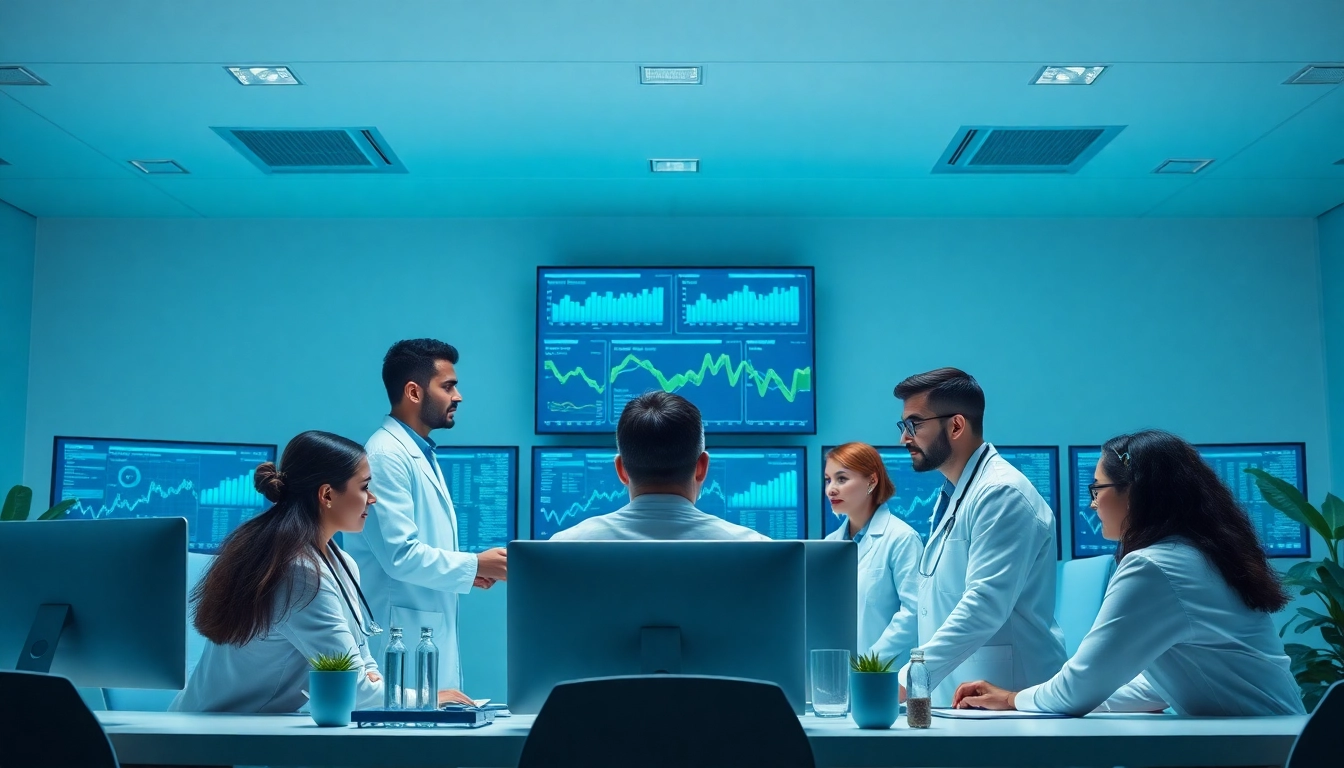Understanding Informatics and Its Impact on Health
In today’s fast-paced healthcare environment, the integration of informatics into medical practice is no longer optional—it’s essential. Informatics, particularly health informatics, is the science of how data, information, and knowledge can be used to improve human health and enhance the delivery of healthcare services. With advancements in technology, the importance of informatics has surged, making it a critical focus area for healthcare professionals and organizations. This article delves into the fundamentals of health informatics, key technologies, significant roles within the field, challenges faced, and future trends, offering an in-depth exploration of how informatics reshapes healthcare.
As healthcare evolves, so too does the need for effective information management. For those seeking to delve deeper into this subject, resources can be found at https://www.informaticsview.com, which provides comprehensive insights into the world of informatics.
The Fundamentals of Health Informatics
Health informatics is an interdisciplinary field that focuses on the collection, storage, retrieval, and use of health information to promote better health outcomes. Combining elements from computer science, information science, cognitive science, and social science, health informatics enables healthcare providers to access and utilize electronic health records (EHRs), clinical decision support systems (CDSS), and other technological tools. This foundation not only allows for more efficient patient care but also supports evidence-based decision-making that improves treatment quality.
Key Technologies in Health Informatics
Numerous technologies serve as the backbone of health informatics, each contributing to improved patient care and streamlined operations:
- Electronic Health Records (EHRs): EHRs enable the digital storage of patient records, facilitating real-time access for healthcare providers and ensuring comprehensive, up-to-date patient information.
- Health Information Exchange (HIE): HIE allows different healthcare organizations to share patient data seamlessly, enhancing coordination of care among various providers.
- Telemedicine: This technology enables remote consultations between patients and healthcare professionals, increasing access to care, especially in underserved areas.
- Wearable Health Technology: Wearable devices collect health data (e.g., heart rate, activity levels) which can be analyzed to monitor patient conditions or guide preventive measures.
- Clinical Decision Support Systems (CDSS): CDSS provides clinicians with tools that analyze data and support clinical decisions, improving diagnostic accuracy and treatment effectiveness.
Case Studies Showcasing Health Data Transformation
Several case studies illustrate how health informatics can transform patient care:
One notable example is the implementation of EHR systems at the Mayo Clinic. By transitioning from paper records to an integrated EHR system, the clinic significantly improved its patient data management, reducing the time spent on documentation and enhancing communication among providers. This change led to better patient outcomes, as clinicians could access complete medical histories and initiate evidence-based treatments more efficiently.
Another example can be seen in the use of telemedicine during the COVID-19 pandemic. Providers who rapidly adopted telehealth services were able to continue offering care while minimizing exposure risks, demonstrating how informatics can facilitate uninterrupted healthcare access under challenging circumstances.
Roles and Responsibilities in Health Informatics
Healthcare Data Analysts and Their Importance
Data analysts are integral to the healthcare ecosystem, tasked with interpreting vast amounts of data to generate actionable insights. By applying statistical techniques and data visualization tools, data analysts help identify trends in patient care and outcomes, enabling organizations to make informed policy decisions and improve service delivery.
Moreover, data analysts play a crucial role in quality control by monitoring adherence to standards and benchmarks, allowing healthcare organizations to continually adapt and refine their practices in line with best practices.
Clinical Informaticians and Decision-Making
Clinical informaticians bridge the gap between healthcare and technology. They leverage their expertise to ensure that information systems effectively support clinical workflows and enhance patient safety. Their deep understanding of medical practices enables them to contribute to the design of user-friendly systems that prioritize clinician needs and promote efficiency.
By analyzing clinical processes and providing recommendations for system enhancements, clinical informaticians help clinicians make better-informed decisions, thereby improving patient care outcomes.
Collaboration Between IT and Healthcare Professionals
Successful health informatics initiatives depend on robust collaboration between IT specialists and healthcare professionals. This partnership facilitates the effective incorporation of technology into clinical practice and ensures that systems align with the specific needs of healthcare providers.
Regular feedback loops and joint workshops can significantly enhance communication across these teams, leading to more innovative solutions and improved user satisfaction.
Challenges in Implementing Informatics Solutions
Data Privacy Concerns in Health Informatics
While the benefits of health informatics are substantial, significant challenges remain—chief among them is the issue of data privacy. With the increasing reliance on digital systems to store sensitive patient information, healthcare organizations must adhere to strict regulatory standards and implement robust security measures to protect patient data from breaches.
Employing encryption, access controls, and regular security audits are critical steps that organizations must take to mitigate risks associated with data handling.
Integration Issues with Existing Systems
Another common challenge is the integration of new informatics systems with legacy systems. Health organizations often operate with a patchwork of outdated technologies that may not easily connect with modern data management tools. This lack of compatibility can lead to data silos and inefficiencies within clinical workflows.
To overcome integration hurdles, organizations should conduct thorough needs assessments and prioritize solutions built with interoperability in mind, ensuring seamless data sharing across platforms.
User Acceptance and Training Needs
Even the most advanced technologies can falter if not embraced by users. Resistance to change among healthcare staff poses a considerable barrier to implementing informatics solutions. Comprehensive training programs that emphasize the practical benefits of new technologies are essential to foster acceptance and ensure successful adoption.
Incorporating user feedback into technology upgrades and providing ongoing support can further enhance user satisfaction and overall effectiveness of informatics tools.
Future Trends in Health Informatics
The Rise of Artificial Intelligence in Health
Artificial Intelligence (AI) is poised to revolutionize health informatics by enabling the automation of data analysis and improving predictive capabilities. Machine learning algorithms can analyze patient data to identify patterns and forecast potential health issues, thus supporting preventive care efforts.
AI-powered tools can also assist clinicians in decision-making processes by providing recommendations based on vast clinical data sets, further enhancing the precision and accuracy of healthcare delivery.
Telehealth: A New Frontier for Patient Care
The rapid adoption of telehealth during the pandemic revealed its potential to transform patient care significantly. As technology continues to advance, telehealth will likely become a fundamental component of healthcare service delivery, providing patients with increased access to care and convenience.
Future generations of telehealth platforms will likely incorporate augmented reality and virtual reality technologies, enabling more immersive interactions between providers and patients, thereby enhancing the overall patient experience.
Predictive Analytics in Population Health Management
Predictive analytics will play an essential role in managing population health, allowing healthcare organizations to identify at-risk communities and tailor interventions accordingly. By analyzing historical health data, organizations can uncover trends in disease prevalence and healthcare utilization, supporting proactive strategies that improve health outcomes across populations.
This capability enables healthcare providers to allocate resources more effectively and focus on preventive measures that address the root causes of health disparities.
Measuring Success in Health Informatics Initiatives
Key Performance Indicators for Health Informatics
To assess the impact of informatics solutions, organizations must establish key performance indicators (KPIs) that provide insights into the effectiveness of their initiatives. Common KPIs include patient satisfaction scores, reductions in clinical errors, and improvements in workflow efficiency. Regularly tracking these metrics ensures that organizations remain accountable and can make data-driven decisions about future investments in informatics.
Evaluating User Engagement and Satisfaction
User engagement is a vital metric for gauging the success of informatics initiatives. Surveys, focus groups, and usage analytics can provide valuable insights into how clinicians and staff interact with technology. Understanding these dynamics allows organizations to make adjustments that enhance user experience and drive better healthcare outcomes.
Continuous Improvement Through Feedback Loops
Establishing continuous feedback loops between users and informatics leaders is crucial for ongoing success. Organizations can cultivate a culture of continuous improvement by encouraging users to report issues, suggest enhancements, and share experiences with technology. This collaboration helps ensure that health informatics solutions evolve alongside the changing needs of healthcare providers and patients.



